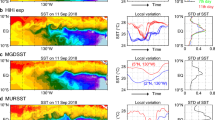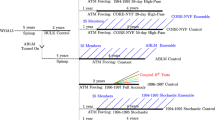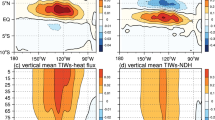Abstract
The coupling between wind stress perturbations and sea surface temperature (SST) perturbations induced by tropical instability waves (TIWs) in the Pacific Ocean has been revealed previously and proven crucial to both the atmosphere and ocean. However, an overlooked fact by previous studies is that the loosely defined “TIWs” actually consist of two modes, including the Yanai wave-based TIW on the equator (hereafter eTIW) and the Rossby wave-based TIW off the equator (hereafter vTIW). Hence, the individual feedbacks of the wind stress to the bimodal TIWs remain unexplored. In this study, individual coupling relationships are established for both eTIW and vTIW, including the relationship between the TIW-induced SST perturbations and two components of wind stress perturbations, and the relationship between the TIW-induced wind stress perturbation divergence (curl) and the downwind (crosswind) TIW-induced SST gradients. Results show that, due to different distributions of eTIW and vTIW, the coupling strength induced by the eTIW is stronger on the equator, and that by the vTIW is stronger off the equator. The results of any of eTIW and vTIW are higher than those of the loosely defined TIWs. We further investigated how well the coupling relationships remained in several widely recognized oceanic general circulation models and fully coupled climate models. However, the coupling relationships cannot be well represented in most numerical models. Finally, we confirmed that higher resolution usually corresponds to more accurate simulation. Therefore, the coupling models established in this study are complementary to previous research and can be used to refine the oceanic and coupled climate models.
Similar content being viewed by others
Data Availability Statement
All data analyzed in this study are publicly available. The NOAA OISST V2 high resolution dataset data provided by the NOAA PSL, Boulder, Colorado, USA, from their website at https://psl.noaa.gov. The ASCAT data are produced by Remote Sensing Systems and sponsored by the NASA Ocean Vector Winds Science Team, data are available at www.remss.com. The HYCOM data was funded by the U.S. Navy and the Modeling and Simulation Coordination Office, and was made available by the DoD High Performance Computing Modernization Program. The output is publicly available at http://hycom.org/. The ECCO2 data are available at http://apdrc.soest.hawaii.edu/data/. The data from the CMIP6 were downloaded from https://esgf-node.llnl.gov/projects/cmip6/.
References
Bentamy A, Croize-Fillon D, Perigaud C. 2008. Characterization of ASCAT measurements based on buoy and QuikSCAT wind vector observations. Ocean Science, 4(4): 265–274, https://doi.org/10.5194/os-4-265-2008.
Bleck R. 2002. An oceanic general circulation model framed in hybrid isopycnic-Cartesian coordinates. Ocean Modelling, 4(1): 55–88, https://doi.org/10.1016/S1463-5003(01)00012-9.
Brook D. 1980. Review: [Untitled]: reviewed work: statistics: concepts and controversies. By D. S. Moore. Journal of the Royal Statistical Society: Series A (General), 143(2): 204, https://doi.org/10.2307/2982004.
Bryan F O, Tomas R, Dennis J M et al. 2010. Frontal scale air-sea interaction in high-resolution coupled climate models. Journal of Climate, 23(23): 6277–6291, https://doi.org/10.1175/2010jcli3665.1.
Byrne D, Papritz L, Frenger I et al. 2015. Atmospheric response to mesoscale sea surface temperature anomalies: assessment of mechanisms and coupling strength in a high-resolution coupled model over the South Atlantic. Journal of the Atmospheric Sciences, 72(5): 1872–1890, https://doi.org/10.1175/jas-d-14-0195.1.
Chassignet E P, Hurlburt H E, Smedstad O M et al. 2006. Ocean prediction with the hybrid coordinate ocean model (HYCOM). In: Chassignet E P, Verron J eds. Ocean Weather Forecasting. Springer, Dordrecht, p. 413–426, https://doi.org/10.1007/1-4020-4028-8_16.
Chassignet E P, Smith L T, Halliwell G R et al. 2003. North Atlantic simulations with the hybrid coordinate ocean model (HYCOM): impact of the vertical coordinate choice, reference pressure, and thermobaricity. Journal of Physical Oceanography, 33(12): 2504–2526, https://doi.org/10.1175/1520-0485(2003)033<2504:NASWTH>2.0.CO;2.
Chavez F P, Strutton P G, Friederich G E et al. 1999. Biological and chemical response of the equatorial pacific ocean to the 1997–98 El Nino. Science, 286(5447): 2126–2131, https://doi.org/10.1126/science.286.5447.2126.
Chelton D B, Esbensen S K, Schlax M G et al. 2001. Observations of coupling between surface wind stress and sea surface temperature in the eastern tropical Pacific. Journal of Climate, 14(7): 1479–1498, https://doi.org/10.1175/1520-0442(2001)014<1479:OOCBSW>2.0.CO;2.
Chelton D B, Schlax M G, Freilich M H et al. 2004. Satellite measurements reveal persistent small-scale features in ocean winds. Science, 303(5660): 978–983, https://doi.org/10.1126/science.1091901.
Chelton D B, Schlax M G, Samelson R M. 2007. Summertime coupling between sea surface temperature and wind stress in the California current system. Journal of Physical Oceanography, 37(3): 495–517, https://doi.org/10.1175/JPO3025.1.
Chelton D B, Wentz F J, Gentemann C L et al. 2000. Satellite microwave SST observations of transequatorial tropical instability waves. Geophysical Research Letters, 27(9): 1239–1242, https://doi.org/10.1029/1999gl011047.
Chelton D B, Xie S P. 2010. Coupled ocean-atmosphere interaction at oceanic mesoscales. Oceanography, 23(4): 52–69, https://doi.org/10.5670/oceanog.2010.05.
Chen L J, Jia Y L, Liu Q Y. 2017. Oceanic eddy-driven atmospheric secondary circulation in the winter Kuroshio Extension region. Journal of Oceanography, 73(3): 295–307, https://doi.org/10.1007/s10872-016-0403-z.
Chen X Y, Hu B, Kimoto M et al. 2009. A numerical simulation study of influence of tropical instability waves on air-sea interaction. Chinese Journal of Atmospheric Sciences, 33(1): 145–154, 10.3878/j.issn.1006–9895.2009.01.13. (in Chinese with English abstract)
Cummings J A, Smedstad O M. 2013. Variational data assimilation for the global ocean. In: Park S K, Xu L eds. Data Assimilation for Atmospheric, Oceanic and Hydrologic Applications. Springer, Berlin, p.303–343, https://doi.org/10.1007/978-3-642-35088-7_13.
Danabasoglu G. 2019a. NCAR CESM2-FV2 model output prepared for CMIP6 CMIP. Earth System Grid Federation, https://doi.org/10.22033/ESGF/CMIP6.11281.
Danabasoglu G. 2019b. NCAR CESM2-WACCM model output prepared for CMIP6 AerChemMIP hist-piNTCF. Earth System Grid Federation, https://doi.org/10.22033/ESGF/CMIP6.10062.
Danabasoglu G. 2020. NCAR CESM2-WACCM-FV2 model output prepared for CMIP6 CMIP amip. Earth System Grid Federation, https://doi.org/10.22033/ESGF/CMIP6.11288.
Deser C, Wallace J M. 1990. Large-scale atmospheric circulation features of warm and cold episodes in the Tropical Pacific. Journal of Climate, 3(11): 1254–1281, https://doi.org/10.1175/1520-0442(1990)003<1254:LSACFO>2.0.CO;2.
Figa-Saldana J, Wilson J J W, Attema E et al. 2002. The advanced scatterometer (ASCAT) on the meteorological operational (MetOp) platform: a follow on for European wind scatterometers. Canadian Journal of Remote Sensing, 28(3): 404–412, https://doi.org/10.5589/m02-035.
Flament P J, Kennan S C, Knox R A et al. 1996. The three-dimensional structure of an upper ocean vortex in the tropical Pacific Ocean. Nature, 383(6601): 610–613, https://doi.org/10.1038/383610a0.
Frenger I, Gruber N, Knutti R et al. 2013. Imprint of Southern Ocean eddies on winds, clouds and rainfall. Nature Geoscience, 6(8): 608–612, https://doi.org/10.1038/ngeo1863.
Halliwell G R. 2004. Evaluation of vertical coordinate and vertical mixing algorithms in the Hybrid-Coordinate Ocean Model (HYCOM). Ocean Modelling, 7(3–4): 285–322, https://doi.org/10.1016/j.ocemod.2003.10.002.
Halpern D, Knox R A, Luther D S. 1988. Observations of 20-day period meridional current oscillations in the upper ocean along the Pacific equator. Journal of Physical Oceanography, 18(11): 1514–1534, https://doi.org/10.1175/1520-0485(1988)018<1514:OODPMC>2.0.CO;2.
Hogg A M C, Dewar W K, Berloff P et al. 2009. The effects of mesoscale ocean-atmosphere coupling on the large-scale ocean circulation. Journal of Climate, 22(15): 4066–4082, https://doi.org/10.1175/2009jcli2629.1.
Jin X, Dong C M, Kurian J et al. 2009. SST-wind interaction in coastal upwelling: oceanic simulation with empirical coupling. Journal of Physical Oceanography, 39(11): 2957–2970, https://doi.org/10.1175/2009JPO4205.1.
Jin X L, Li Z X, Zheng Z H et al. 2015. Interannual variability of the TIWs and its relationship with the ENSO. Journal of Tropical Oceanography, 34(3): 30–35, https://doi.org/10.3969/j.issn.1009-5470.2015.03.004. (in Chinese with English abstract)
Keeble J, Hassler B, Banerjee A et al. 2021. Evaluating stratospheric ozone and water vapour changes in CMIP6 models from 1850 to 2100. Atmospheric Chemistry and Physics, 21(6): 5015–5061, https://doi.org/10.5194/acp-21-5015-2021.
Kelly K A, Small R J, Samelson R M et al. 2010. Western boundary currents and frontal air-sea interaction: gulf Stream and Kuroshio Extension. Journal of Climate, 23(21): 5644–5667, https://doi.org/10.1175/2010JCLI3346.1.
Lanczos C. 1950. An iteration method for the solution of the eigenvalue problem of linear differential and integral operatorsl. Journal of Research of the National Bureau of Standards, 45(4): 255–282.
Legeckis R. 1977. Long waves in the eastern equatorial Pacific Ocean: a view from a geostationary satellite. Science, 197(4309): 1179–1181, https://doi.org/10.1126/science.197.4309.1179.
Lindzen R S, Nigam S. 1987. On the role of sea surface temperature gradients in forcing low-level winds and convergence in the tropics. Journal of the Atmospheric Sciences, 44(17): 2418–2436, https://doi.org/10.1175/1520-0469(1987)044<2418:OTROSS>2.0.CO;2.
Liu C Y, Wang X W, Köhl A et al. 2019. The northeast-southwest oscillating equatorial mode of the tropical instability wave and its impact on equatorial mixing. Geophysical Research Letters, 46(1): 218–225, https://doi.org/10.1029/2018GL080226.
Liu W T, Xie X S, Polito P S et al. 2000. Atmospheric manifestation of tropical instability wave observed by QuikSCAT and Tropical Rain Measuring Mission. Geophysical Research Letters, 27(16): 2545–2548, https://doi.org/10.1029/2000gl011545.
Lyman J M, Johnson G C, Kessler W S. 2007. Distinct 17-and 33-day tropical instability waves in subsurface Observations. Journal of Physical Oceanography, 37(4): 855–872, https://doi.org/10.1175/jpo3023.1.
Ma X H, Chang P, Saravanan R et al. 2015. Distant influence of Kuroshio eddies on north Pacific weather patterns?. Scientific Reports, 5: 17785, https://doi.org/10.1038/srep17785.
Maloney E D, Chelton D B. 2006. An assessment of the sea surface temperature influence on surface wind stress in numerical weather prediction and climate models. Journal of Climate, 19(12): 2743–2762, https://doi.org/10.1175/jcli3728.1.
Marshall J, Adcroft A, Hill C et al. 1997. A finite-volume, incompressible Navier Stokes model for studies of the ocean on parallel computers. Journal of Geophysical Research, 102(C3): 5753–5766, https://doi.org/10.1029/96jc02775.
Menemenlis D, Campin J, Heimbach P et al. 2008. ECCO2: High Resolution Global Ocean and Sea Ice Data Synthesis. Mercator Ocean Quarterly Newsletter, 31: 13–21.
Menemenlis D, Hill C, Adcrocft A et al. 2005. NASA supercomputer improves prospects for ocean climate research. Eos, Transactions American Geophysical Union, 86(9): 89–96, https://doi.org/10.1029/2005eo090002.
Menkes C E, Kennan S C, Flament P et al. 2002. A whirling ecosystem in the equatorial Atlantic. Geophysical Research Letters, 29(11): 1553, https://doi.org/10.1029/2001GL014576.
Milliff R F, Morzel J, Chelton D B et al. 2004. Wind stress curl and wind stress divergence biases from rain effects on QSCAT surface wind retrievals. Journal of Atmospheric and Oceanic Technology, 21(8): 1216–1231, https://doi.org/10.1175/1520-0426(2004)021<1216:wscaws>2.0.co;2.
Mitchell T P, Wallace J M. 1992. The annual cycle in equatorial convection and sea surface temperature. Journal of Climate, 5(10): 1140–1156, https://doi.org/10.1175/1520-0442(1992)005<1140:TACIEC>2.0.CO;2.
Neubauer D, Ferrachat S, Siegenthaler-Le Drian et al. 2019. HAMMOZ-Consortium MPI-ESM1.2-HAM model output prepared for CMIP6 CMIP historical. Earth System Grid Federation, https://doi.org/10.22033/ESGF/CMIP6.1622.
Niemeier U, Wieners K H, Giorgetta M et al. 2019. MPI-M MPI-ESM1. 2-HR model output prepared for CMIP6 GeoMIP G6sulfur. Earth System Grid Federation, https://doi.org/10.22033/ESGF/CMIP6.15300.
O’Neill L W, Chelton D B, Esbensen S K. 2010. The effects of SST-induced surface wind speed and direction gradients on midlatitude surface vorticity and divergence. Journal of Climate, 23(2): 255–281, https://doi.org/10.1175/2009jcli2613.1.
Pezzi L P, Vialard J, Richards K J et al. 2004. Influence of ocean-atmosphere coupling on the properties of tropical instability waves. Geophysical Research Letters, 31(16): L16306, https://doi.org/10.1029/2004GL019995.
Putrasahan D A, Miller A J, Seo H. 2013. Isolating mesoscale coupled ocean-atmosphere interactions in the Kuroshio Extension region. Dynamics of Atmospheres and Oceans, 63: 60–78, https://doi.org/10.1016/j.dynatmoce.2013.04.001.
Reynolds R W, Smith T M, Liu C Y et al. 2007. Daily high-resolution-blended analyses for sea surface temperature. Journal of Climate, 20(22): 5473–5496, https://doi.org/10.1175/2007jcli1824.1.
Ricciardulli L, Wentz F J. 2016. Remote sensing systems ASCAT C-2015 daily ocean vector winds on 0.25 DEG grid. Remote Sensing Systems, Santa Rosa.
Schneider N, Qiu B. 2015. The atmospheric response to weak sea surface temperature fronts. Journal of the Atmospheric Sciences, 72(9): 3356–3377, https://doi.org/10.1175/JAS-D-14-0212.1.
Small R J, Deszoeke S P, Xie S P et al. 2008. Air-sea interaction over ocean fronts and eddies. Dynamics of Atmospheres and Oceans, 45(3–4): 274–319, https://doi.org/10.1016/j.dynatmoce.2008.01.001.
Song Q T, Chelton D B, Esbensen S K et al. 2009. Coupling between sea surface temperature and low-level winds in mesoscale numerical models. Journal of Climate, 22(1): 146–164, https://doi.org/10.1175/2008jcli2488.1.
Spall M A. 2007. Midlatitude wind stress-sea surface temperature coupling in the vicinity of oceanic fronts. Journal of Climate, 20(15): 3785–3801, https://doi.org/10.1175/jcli4234.1.
Tang Z J, Zhang R H, Wang H N et al. 2021. Mesoscale surface wind-SST coupling in a high-resolution CESM over the KE and ARC regions. Journal of Advances in Modeling Earth Systems, 13(12): e2021MS002822, https://doi.org/10.1029/2021MS002822.
Thum N, Esbensen S K, Chelton D B et al. 2002. Air-sea heat exchange along the northern sea surface temperature front in the eastern tropical Pacific. Journal of Climate, 15(23): 3361–3378, https://doi.org/10.1175/1520-0442(2002)015<3361:ASHEAT>2.0.CO;2.
Verspeek J, Stoffelen A, Portabella M, et al. 2010. Validation and Calibration of ASCAT using CMOD5.n. IEEE Transactions on Geoscience and Remote Sensing, 48(1): 386–395, https://doi.org/10.1109/TGRS.2009.2027896.
Wallace J M, Mitchell T P, Deser C. 1989. The Influence of sea-Surface temperature on surface wind in the eastern equatorial Pacific: seasonal and interannual variability. Journal of Climate, 2(12): 1492–1499, https://doi.org/10.1175/1520-0442(1989)002<1492:TIOSST>2.0.CO;2.
Wang M Y, Du Y, Qiu B et al. 2019. Dynamics on seasonal variability of EKE associated with TIWs in the eastern equatorial Pacific ocean. Journal of Physical Oceanography, 49(6): 1503–1519, https://doi.org/10.1175/JPO-D-18-0163.1.
Wei Y Z, Kang X B, Pei Y H. 2018. An empirical tropical instability wave-induced wind stress model in the equatorial Pacific and its incorporation into the ocean model. Atmosphere-Ocean, 56(5): 350–361, https://doi.org/10.1080/07055900.2018.1549016.
Wei Y Z, Pei Y H, Kang X B. 2019. Assessing feedback of tropical instability wave-induced wind stress perturbations in the Equatorial Pacific. International Journal of Climatology, 39(3): 1634–1643, https://doi.org/10.1002/joc.5906.
Wu Q Y, Bowman K P. 2007. Interannual variations of tropical instability waves observed by the Tropical Rainfall Measuring Mission. Geophysical Research Letters, 34(9): L09701, https://doi.org/10.1029/2007GL029719.
Xie S P. 2004. Satellite observations of cool ocean-atmosphere interaction. Bulletin of the American Meteorological Society, 85(2): 195–208, https://doi.org/10.1175/BAMS-85-2-195.
Xie S P, Ishiwatari M, Hashizume H et al. 1998. Coupled ocean-atmospheric waves on the equatorial front. Geophysical Research Letters, 25(20): 3863–3866, https://doi.org/10.1029/1998gl900014.
Zhang R H. 2014. Effects of tropical instability wave (TIW)-induced surface wind feedback in the tropical Pacific Ocean. Climate Dynamics, 42(1–2): 467–485, https://doi.org/10.1007/s00382-013-1878-6.
Zhang R H. 2016. A modulating effect of Tropical Instability Wave (TIW)-induced surface wind feedback in a hybrid coupled model of the tropical Pacific. Journal of Geophysical Research, 121(10): 7326–7353, https://doi.org/10.1002/2015jc011567.
Zhang R H, Busalacchi A J. 2008. Rectified effects of tropical instability wave (TIW)-induced atmospheric wind feedback in the tropical Pacific. Geophysical Research Letters, 35(5): L05608, https://doi.org/10.1029/2007GL033028.
Zhang R H, Busalacchi A J. 2009. An empirical model for surface wind stress response to SST forcing induced by tropical instability waves (TIWs) in the eastern equatorial Pacific. Monthly Weather Review, 137(6): 2021–2046, https://doi.org/10.1175/2008MWR2712.1.
Acknowledgment
We thank the working groups responsible for the above datasets.
Author information
Authors and Affiliations
Corresponding author
Additional information
Supported by the National Natural Science Foundation of China (No. 41976012), the Key Research Program of Laoshan Laboratory (LSL) (No. LSKJ202202502), and the Strategic Priority Research Program of Chinese Academy of Sciences (CAS) (No. XDB42000000)
Rights and permissions
About this article
Cite this article
Ma, K., Liu, C., Xu, J. et al. Contrasts of bimodal tropical instability waves (TIWs)-induced wind stress perturbations in the Pacific Ocean among observations, ocean models, and coupled climate models. J. Ocean. Limnol. 42, 1–23 (2024). https://doi.org/10.1007/s00343-023-2326-z
Received:
Accepted:
Published:
Issue Date:
DOI: https://doi.org/10.1007/s00343-023-2326-z




